Homeowners Insurance
2024 Porch Pirates Report
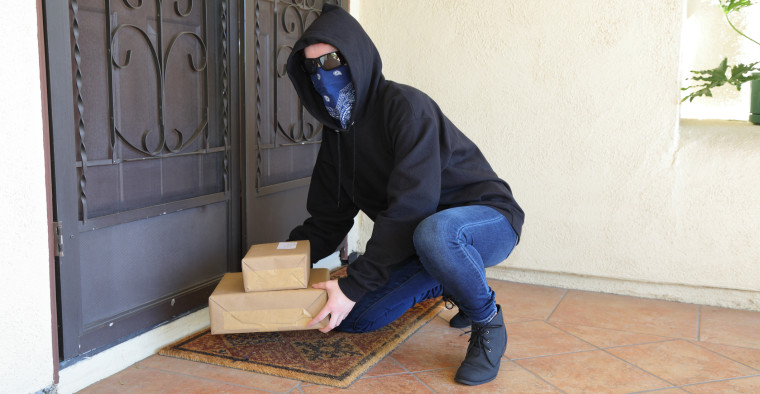
Aargh! Porch pirates are a modern-day menace, and there’s no sign they’re abandoning the shipped packages of millions of Americans anytime soon. In fact, they’ve amped up their efforts in recent years.
The latest ValuePenguin study of nearly 2,050 Americans finds that 41% have been a victim of porch piracy, up from 35% in 2022.
How to fight back? Shipping insurance can help. Among the 23% of Americans who’ve gotten shipping insurance due to theft fears, 86% say it was worth it. Read more about the prevalence of porch pirates and how Americans attempt to protect their packages from them.
On this page
Key findings
- As e-commerce continues to thrive, porch piracy is on the rise. 41% of Americans have been a victim of porch piracy, up from 35% in 2022. Additionally, 25% say they’ve had a package stolen in the past year, up from 21% in 2022.
- Many Americans have been repeat victims. Over a quarter (27%) of those who’ve been victims in the past year say they’ve had three or more packages stolen, with nearly 2 in 3 (63%) saying at least one originated from Amazon or Walmart. When asked about the location of the most recent theft, 55% said front doors or porches, 14% said mailboxes and 13% said mail rooms.
- Americans look to video doorbells and more to deter porch pirates. Over half (54%) of Americans use cameras for home security, and 22% of Americans say they installed one in the past year to prevent package theft. Additionally, 13% say they’ve confronted a thief attempting to steal a package from their house — 72% of whom say the confrontation worked.
- Most resolved their incidents, and some turned to insurance. 55% of theft victims in the past year filed a claim with the seller, 31% did so with the shipping company and 29% reported an incident to the police. Among Americans who’ve been victims of package theft in the past year and beyond, 58% got all their money back or received a free replacement the most recent time. Of the 23% of Americans who’ve gotten shipping insurance due to theft fears, 86% say it was worth it and 48% have filed a claim.
Porch piracy on rise
Americans’ porches are busier than ever with the onslaught of online shopping, meal deliveries, grocery drops and more. They’re also becoming hot spots for pesky porch pirates who swoop onto stoops and grab what’s not theirs.
Our study finds that 41% of Americans have had a package or delivery stolen at least once. One in 4 (25%) had one stolen in the past year (since September 2023), while 14% had one stolen in the past three months (since June 2024).
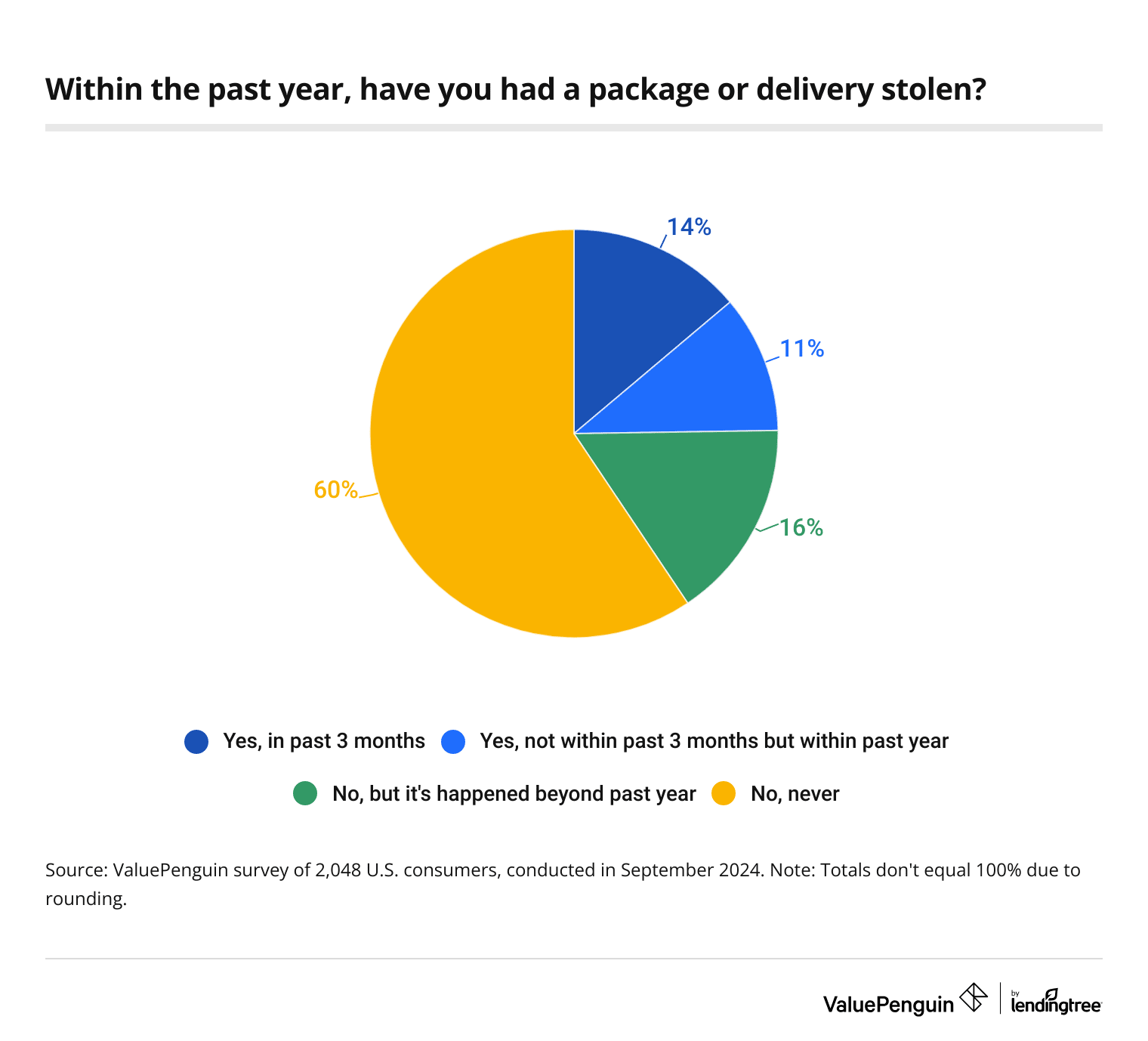
Older generations are significantly less likely to report being victims of porch piracy than their younger counterparts. In fact, 81% of baby boomers (ages 60 to 78) and 65% of Gen Xers (ages 44 to 59) say they’ve never had a package stolen, versus 46% of Gen Zers (ages 18 to 27) and millennials (ages 28 to 43).
Gen Zers have been most vulnerable to porch pirates in the past year, with 39% reporting packages or deliveries stolen in that time frame — a rate about 5.5 times higher than that of baby boomers. Meanwhile, those who live in single-family homes (62%) are more likely to have evaded porch pirates than those in town houses (48%) or apartment buildings (53%).
Porch pirates show no signs of slowing down, as rates of their menacing ways continue to rise. Our last study in 2022 found that 35% of Americans had been a victim of porch piracy, compared with 41% in our newest study. Also, the number of people who said they’d had a package stolen in the past year rose from 21% in 2022 to 25% in 2024. Blimey!
Why are these bandits so brazen? Some say penalties aren’t stiff enough. While stealing mail sent through the U.S. Postal Service is a federal crime, theft of items sent through other carriers, such as UPS and FedEx, isn’t.
ValuePenguin home insurance expert Divya Sangameshwar says lawmakers nationwide are trying to fix this gap and crack down on porch piracy with stricter laws. Federally, U.S. Rep. Dean Phillips (D-Minn.) introduced the Porch Pirates Act in July 2024 to extend federal mail theft penalties to all packages, including those delivered by private carriers.
State authorities are also cracking down on porch pirates. Eleven states have passed laws increasing the penalty for package theft from a misdemeanor to a felony, including:
- Arkansas
- Florida
- Georgia
- Kentucky
- Michigan
- Missouri
- New Jersey
- Oklahoma
- Pennsylvania
- Tennessee
- Texas
California, Kansas, New York and South Carolina are also working to pass similar legislation, according to Security.org.
These additional deterrents can’t happen soon enough, as 30% of Americans say they’ve heard a neighbor has been a victim of porch piracy in the past year. Also, we’re heading toward the holidays, when porch pirates tend to step up their stealing. More than 1 in 10 Americans (11%) say they had a package stolen during the last holiday season. That rate jumps to 18% among Gen Zers and 17% among those who live in town houses and millennials.
How porch pirate victims are hit
One and done? Not for most porch pirate victims. Of those who’ve been victims in the past year, 59% say they’ve had two or more packages stolen. Here’s the full breakdown:
- 41% say 1 package
- 32% say 2 packages
- 20% say 3 packages
- 3% say 4 packages
- 4% say 5 or more packages
As for the types of packages being poached, those from Walmart and Amazon are at the top of the list. Nearly 2 in 3 (63%) of those who’ve been porch pirate victims in the past year say they’ve had a package from one of these giant retailers stolen.
That’s followed by:
- Packages ordered online from sites other than Amazon or Walmart (38%)
- A meal/grocery delivery, such as HelloFresh or Instacart (16%)
- A package someone else sent, such as a birthday gift (8%)
- A different type of package (7%)
It’s not just porches from which packages are being pilfered. While 55% of those who’ve been victims of porch pirates in the past year say their most recent package was stolen from outside their front door/porch, others report having it stolen from their mailbox (14%), their building’s mail room (13%) and even out of a locker for packages (4%).
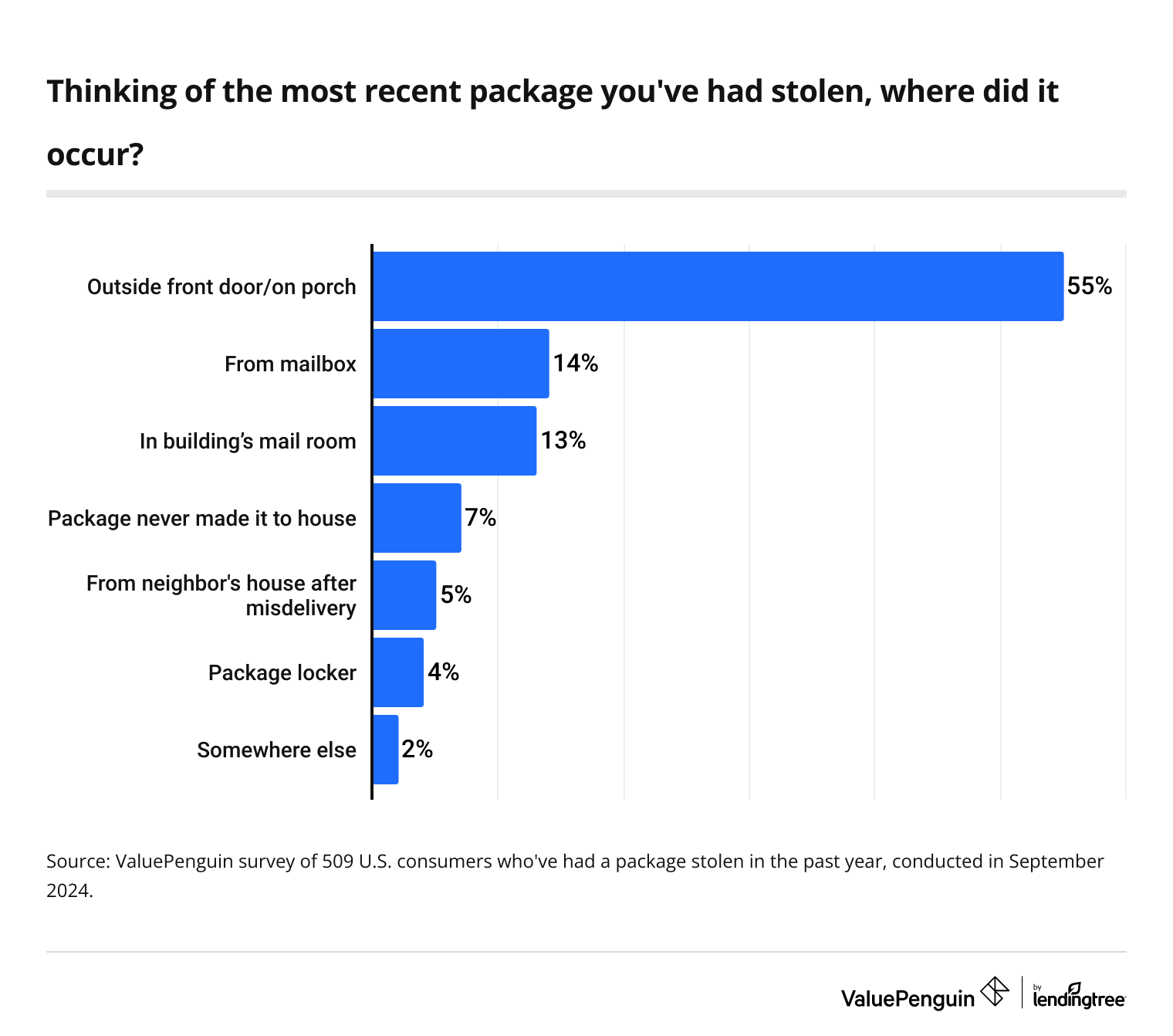
Are victims doing the right things to deter porch pirates?
So, what are Americans doing to thwart porch piracy? More than half (54%) have home security cameras. The younger generations are more likely to have them than their older counterparts — 70% of Gen Zers and 66% of millennials, versus 47% of Gen Xers and 35% of baby boomers. And single-family homeowners are more likely to have video doorbells and security cameras (59%) than town house (57%) and apartment dwellers (42%).
But is the threat of porch piracy enough for Americans to give up the convenience of online shopping? Most haven’t gone that far, with 62% saying they haven’t changed the frequency with which packages are shipped to their home in the past year. In fact, 21% say they’ve had more packages shipped in the past year.
The most frequent precaution consumers report taking to prevent porch piracy in the past year is setting up tracking notifications (35%), while 22% installed a camera and 21% modified a delivery time to ensure they’d be home. Only 12% purchased insurance from the delivery system or store, but more on that later.
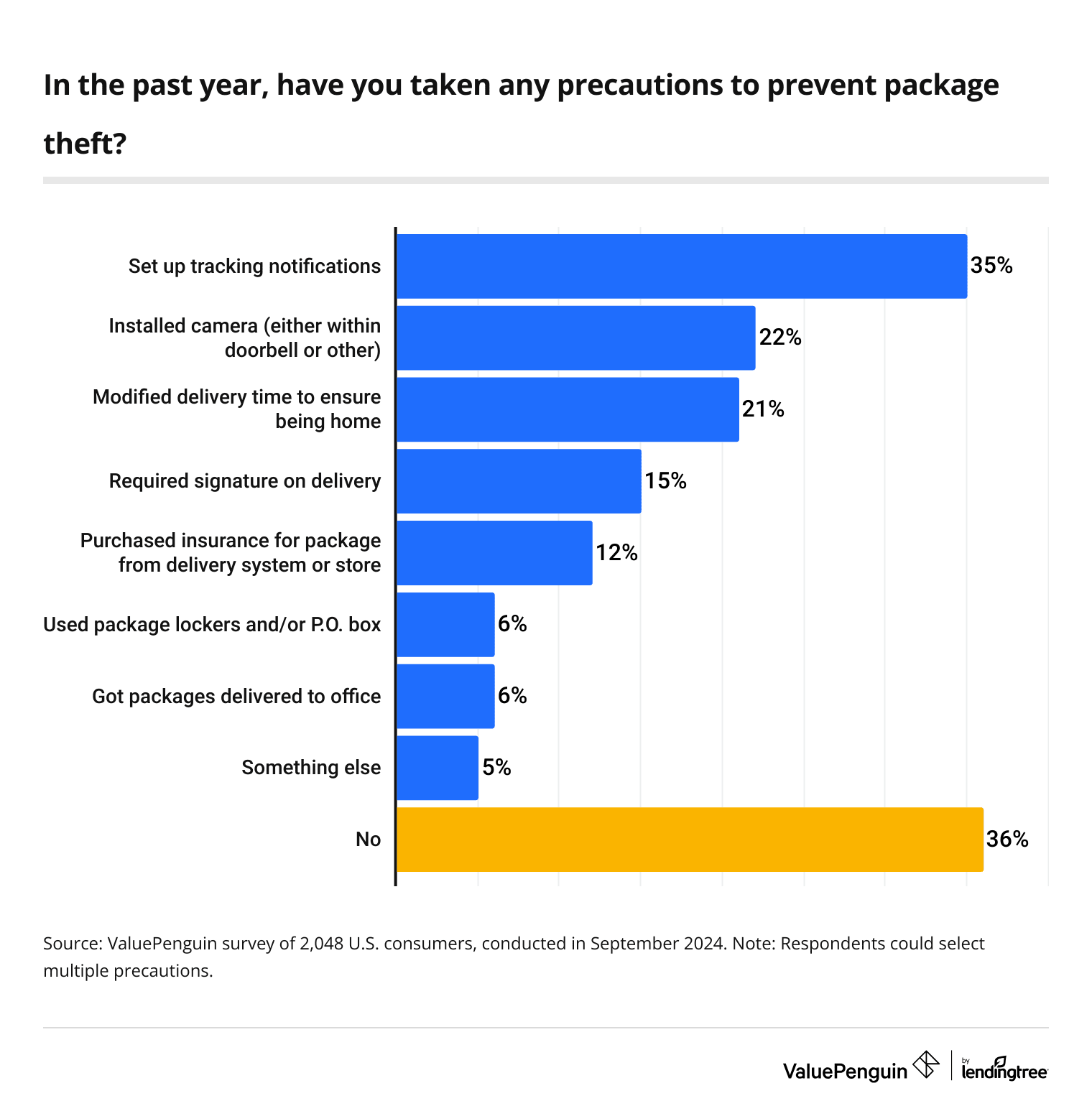
Caught in the act? Some consumers (13%) have confronted the thieves trying to make off with their packages. More men than women have done so — 18% versus 9%, respectively. And younger generations are more likely to have done so than their older counterparts — 26% of Gen Zers and 21% of millennials, versus 7% of Gen Xers and just 2% of baby boomers. And it worked for the most part, with 72% of those who confronted someone trying to take their package saying it resolved the issue.
What more can consumers do to deter porch pirates? Sangameshwar says Americans are already taking the right steps to prevent porch piracy, but thieves are getting smarter. They know how to dodge cameras and are going as far as following delivery trucks to get to packages as fast as possible.
There are, however, additional steps Sangameshwar suggests consumers take, including:
- Opting for delivery to your workplace
- Asking a trusted neighbor if packages can be delivered to their home
- Requesting a signature delivery or a delivery PIN code
- Requesting ship-to-store or pickup using a package receiving service (like Amazon Locker)
"While these measures may not be feasible for every delivery, they’re helpful for products that package thefts tend to target, like electronics, appliances and other high-value items," she says. "If you plan to get the new iPhone, it may be better to place an order for store pickup than to have it delivered."
Victims try to resolve porch piracy with claims, police reports
If your defenses fail, you’ll have to go on offense to get back what’s rightfully yours. For 55% of those who’ve been porch pirate victims in the past year, that meant filing a claim with the seller of the product that was shipped, while 31% filed a claim with the shipping company. Fewer than one-third (29%) reported the theft to police.
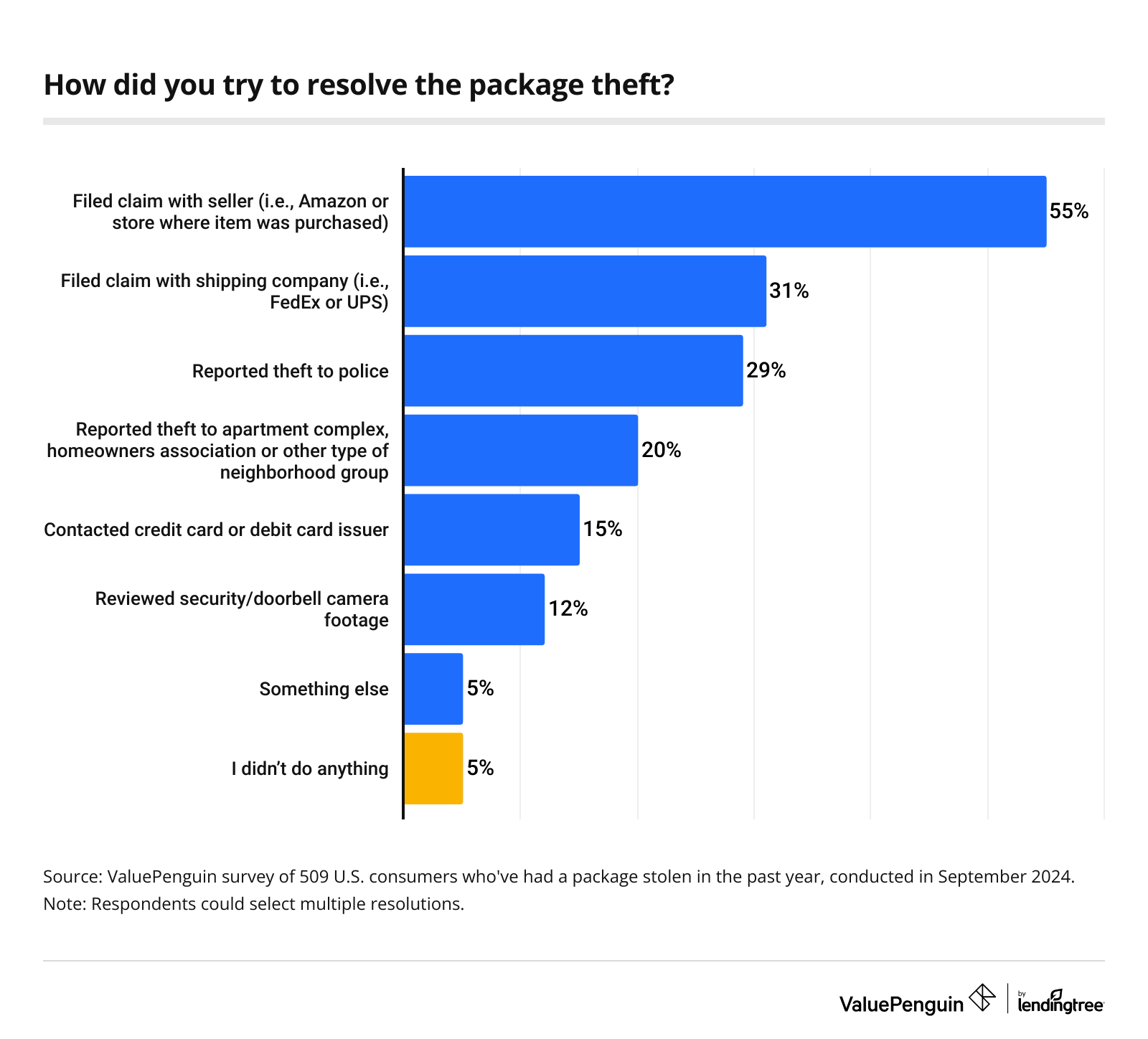
How effective are Americans’ efforts against porch pirates? Of those who’ve been porch pirate victims in the past year, 38% said the thief was caught, 48% said they weren’t and 15% said they weren’t sure. As for getting back what’s rightfully theirs, 58% of porch pirate victims (regardless of the timeline) said they got all their money back or received a replacement item at no additional cost after a theft. Another 16% said they got at least some, but not all, of their money back.
Adding shipping insurance due to theft fears
As for the assurance of insurance, about three-quarters of Americans (73%) say they’ve never purchased shipping insurance. Men, however, are more likely to do so than women (26% of men versus 20% of women), and older generations are less likely to than their younger counterparts — 14% of baby boomers and 21% of Gen Xers, compared with 27% of Gen Zers and 30% of millennials.
The majority of those who have purchased shipping insurance due to theft fears (86%) say it was worth it. Nearly half (48%) who’ve gotten it have filed a claim.
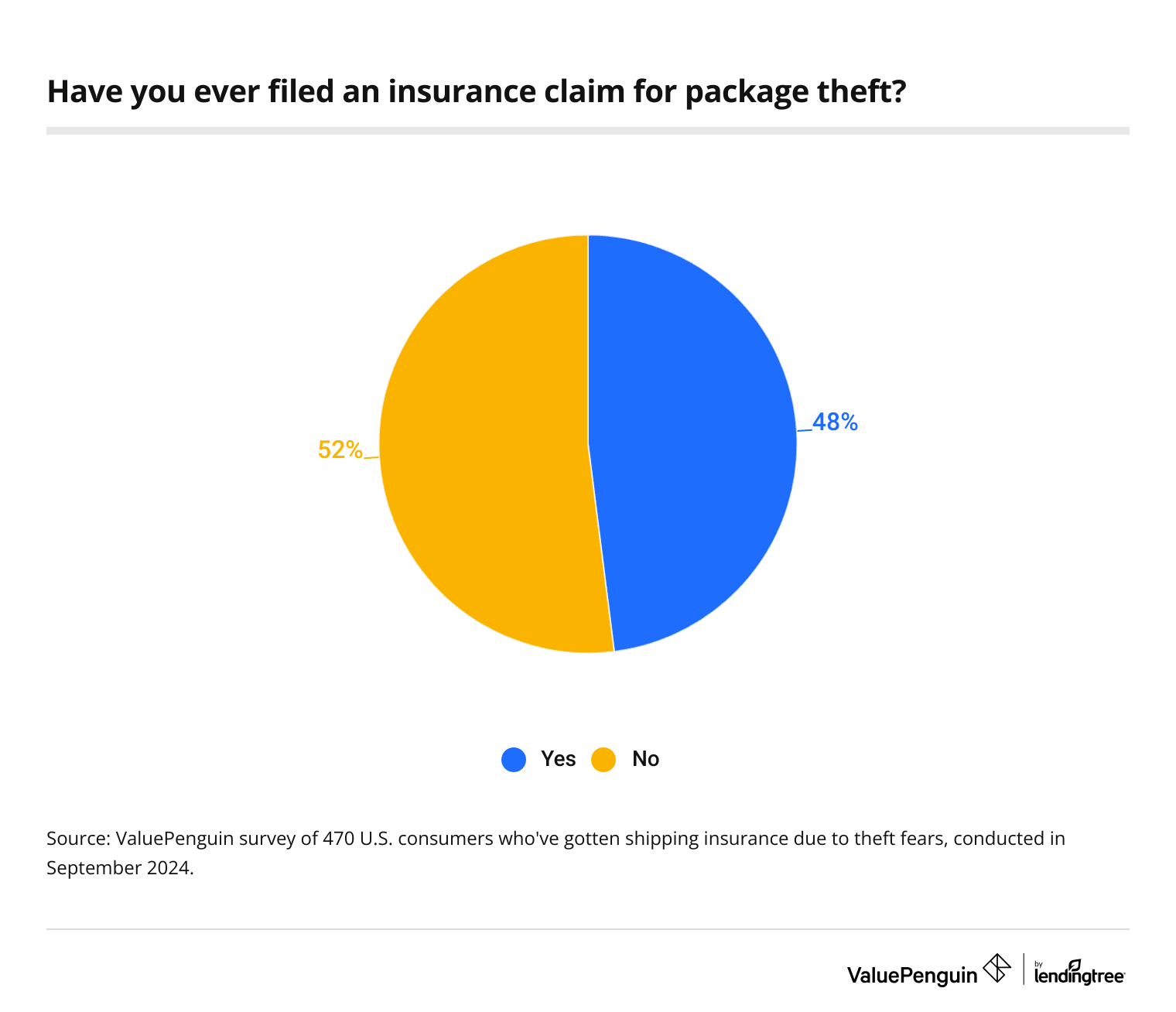
What porch pirate victims should do
If one of your packages is poached, there are steps you can take to be reimbursed or receive a replacement item. Start by tracking the package if you’re able so you can confirm the package was delivered (and not just delayed). Also, check with your neighbors to make sure they didn't take it in for you.
If you determine it’s been stolen, start by contacting the seller, who will hopefully replace the item. If not, you can file a claim with the shipping company or use the protection features on the credit card with which you purchased the item(s) in the package or delivery.
If the value of the stolen items exceeds the deductible of your renters or homeowners insurance, you may want to file a claim.
Sangameshwar encourages consumers to treat porch piracy like any other theft, starting with itemizing the stolen items. You’ll also need to compile the evidence (receipts from the vendor, delivery notifications, photos or video footage of the theft) and notify the police and submit your claim to your insurance company as soon as possible.
She cautions, however, that most homeowners insurance has limits for theft of high-value items, like electronics, fine art or precious jewelry, so you should take extra precautions when ordering those items.
Methodology
ValuePenguin commissioned QuestionPro to conduct an online survey of 2,048 U.S. consumers ages 18 to 78 from Sept. 13 to 17, 2024. The survey was administered using a nonprobability-based sample, and quotas were used to ensure the sample base represented the overall population. Researchers reviewed all responses for quality control.
We defined generations as the following ages in 2024:
- Generation Z: 18 to 27
- Millennial: 28 to 43
- Generation X: 44 to 59
- Baby boomer: 60 to 78